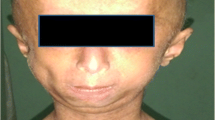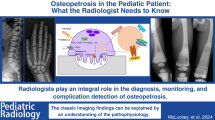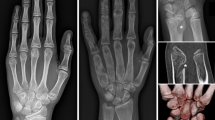Abstract
Background
Progeria is a rare segmental premature aging disease with significant skeletal abnormalities. Defining the full scope of radiologic abnormalities requires examination of a large proportion of the world’s progeria population (estimated at 1 in 4 million). There has been no comprehensive prospective study describing the skeletal abnormalities associated with progeria.
Objective
To define characteristic radiographic features of this syndrome.
Materials and methods
Thirty-nine children with classic progeria, ages 2–17 years, from 29 countries were studied at a single site. Comprehensive radiographic imaging studies were performed.
Results
Sample included 23 girls and 16 boys—the largest number of patients with progeria evaluated prospectively to date. Eight new and two little known progeria-associated radiologic findings were identified (frequencies of 3–36%). Additionally, 23 commonly reported findings were evaluated. Of these, 2 were not encountered and 21 were present and ranked according to their frequency. Nine abnormalities were associated with increasing patient age (P = 0.02–0.0001).
Conclusion
This study considerably expands the radiographic morphological spectrum of progeria. A better understanding of the radiologic abnormalities associated with progeria and improved understanding of the biology of progerin (the molecule responsible for this disease), will improve our ability to treat the spectrum of bony abnormalities.






Similar content being viewed by others
References
De Sandre-Giovannoli A, Bernard R, Cau P et al (2003) Lamin A truncation in Hutchinson-Gilford progeria. Science 300:2055
Eriksson M, Brown WT, Gordon LB et al (2003) Recurrent de novo point mutations in lamin A cause Hutchinson-Gilford progeria syndrome. Nature 423:293–298
Goldman RD, Goldman AE, Shumaker DK (2005) Nuclear lamins: building blocks of nuclear structure and function. Novartis Found Symp 264:3–16, discussion 16–21, 227–230
Bridger JM, Kill IR (2004) Aging of Hutchinson-Gilford progeria syndrome fibroblasts is characterised by hyperproliferation and increased apoptosis. Exp Gerontol 39:717–724
Goldman RD, Shumaker DK, Erdos MR et al (2004) Accumulation of mutant lamin A causes progressive changes in nuclear architecture in Hutchinson-Gilford progeria syndrome. Proc Natl Acad Sci USA 101:8963–8968
McClintock D, Gordon LB, Djabali K (2006) Hutchinson-Gilford progeria mutant lamin A primarily targets human vascular cells as detected by an anti-Lamin A G608G antibody. Proc Natl Acad Sci USA 103:2154–2159
Olive M, Harten I, Mitchell R et al (2010) Cardiovascular pathology in Hutchinson-Gilford progeria: correlation with the vascular pathology of aging. Arterioscler Thromb Vasc Biol 30:2301–2309
Amati F, Biancolella M, D'Apice MR et al (2004) Gene expression profiling of fibroblasts from a human progeroid disease (mandibuloacral dysplasia, MAD #248370) through cDNA microarrays. Gene Expr 12:39–47
Csoka AB, English SB, Simkevich CP et al (2004) Genome-scale expression profiling of Hutchinson-Gilford progeria syndrome reveals widespread transcriptional misregulation leading to mesodermal/mesenchymal defects and accelerated atherosclerosis. Aging Cell 3:235–243
Park WY, Hwang CI, Kang MJ et al (2001) Gene profile of replicative senescence is different from progeria or elderly donor. Biochem Biophys Res Commun 282:934–939
Hennekam RC (2006) Hutchinson-Gilford progeria syndrome: review of the phenotype. Am J Med Genet A 140:2603–2624
Kieran MW, Gordon L, Kleinman M (2007) New approaches to progeria. Pediatrics 120:834–841
Gordon LB, McCarten KM, Giobbie-Hurder A et al (2007) Disease progression in Hutchinson-Gilford progeria syndrome: impact on growth and development. Pediatrics 120:824–833
Taybi H, Lachman R (1996) Progeria. In: Radiology of syndromes, metabolic disorders, and skeletal dysplasia, 4th edn. Mosby Year-Book, St. Louis, MO, pp 401–403
Progeria syndrome (Hutchinson-Gilford syndrome) (2006) In: Jones K (ed) Smith’s recognizable patterns of human malformation, 6th edn. W.B. Saunders Co., Philadelphia, PA, pp 146–149
Gordon CM, Gordon LB, Snyder BD et al (2011) Hutchinson-Gilford progeria is a skeletal dysplasia. J Bone Miner Res 26:1670–1679
Merideth MA, Gordon LB, Clauss S et al (2008) Phenotype and course of Hutchinson-Gilford progeria syndrome. N Engl J Med 358:592–604
Rosenthal IM, Bronstein IP, Dallenback FD et al (1956) Progeria: report of a case with cepalometric roentgenograms and abnormally high concentrations of lipoproteins in serum. Pediatrics 18:565–577
Poznanski A (1984) Metabolic bone disease and other abnormalities of the hand. In: The hand in radiologic diagnosis. W.B. Saunders Co., Philadelphia, PA, pp 839–894
Margolin FR, Steinbach HL (1968) Progeria Hutchinson-Gilford syndrome. AJR 103:173–178
Resnick D (2002) Additional congenital or heritable anomalies and syndromes. In: Resnick D (ed) Diagnosis of bone and joint disorders, 4th edn. W.B. Saunders Co., Philadelphia, PA, pp 4561–4631
Taybi H, Lachman R (1996) Epiphysis: dense, sclerotic, ivory. In: Radiology of syndromes, metabolic disorders, and skeletal dysplasia, 4th edn. Mosby Year-Book, St. Louis, MO, p 1029
Resnick D (2002) Spinal anomalies and curvatures. In: Resnick D (ed) Diagnosis of bone and joint disorders, 4th edn. W.B. Saunders Co., Philadelphia, PA, pp 4534–4559
(1959) Greulich W, Pyle S (eds) Radiographic atlas of skeletal development of the hand and wrist. Stanford University Press, Stanford, CA
Louis D, Greene T, Poznanski A (1984) Burns, frostbite, foreign bodies and other traumatic lesions of the hand. In: Poznanski A (ed) The hand in radiologic diagnosis. W.B. Saunders Co., Philadelphia, PA, pp 708–733
Poznanski A (1984) Joint disorders. In: The hand in radiologic diagnosis. W.B. Saunders Co., Philadelphia, PA, pp 791–838
Taybi H, Lachman R (1996) Scleroderma. In: Radiology of syndromes, metabolic disorders, and skeletal dysplasia, 4th edn. Mosby Year-Book, St. Louis, MO, pp 448–450
Resnick D (2002) Internal derangements of joints. In: Resnick D (ed) Diagnosis of bone and joint disorders, 4th edn. W.B. Saunders Co., Philadelphia, PA, pp 3019–3375
Poznanski A (1984) Normal variation and congenital anomalies of the wrist. In: The hand in radiologic diagnosis. W.B. Saunders Co., Philadelphia, PA, pp 181–208
Taybi H, Lachman R (1996) Ulna/ulnar ray: aplasia, hypoplasia. In: Radiology of syndromes, metabolic disorders, and skeletal dysplasia, 4th edn. Mosby Year-Book, St. Louis, MO, p 1044
Taybi H, Lachman R (1996) Madelung deformity. In: Radiology of syndromes, metabolic disorders, and skeletal dysplasia, 4th edn. Mosby Year-Book, St. Louis, MO, p 1036
Taybi H, Lachman R (1996) Pseudoarthrosis. In: Radiology of syndromes, metabolic disorders, and skeletal dysplasia, 4th edn. Mosby Year-Book, St. Louis, MO, pp 1039–1040
Gerhard-Herman M, Smoot LB, Wake N et al (2012) Mechanisms of premature vascular aging in children with Hutchinson-Gilford progeria syndrome. Hypertension 59:92–97
Acknowledgments
We are grateful to the children with progeria and their families for their participation in this study. We thank the Family Inn (Cambridge, MA) and Devon Nicole House (Boston, MA) for housing families; Susan Campbell, MS, Nancy Wolf-Jenssen, and Nancy Grossman for medical records coordination; and Kyra Johnson, Kelly Littlefield, Kiera McKendrick, Angela Kraybill, and William Fletcher for coordinator services. This project was funded by The Progeria Research Foundation (PRFCLIN2007-01 and Grant #PRFCLINTRIAL003-080109), the National Heart, Lung and Blood Institute (1RC2HL101631-01), the Dana-Farber Cancer Institute Stop&Shop Pediatric Brain Tumor Program, by a National Center for Research Resources to the Children's Hospital Boston General Clinical Research Center (MO1-RR02172), and a grant from the National Center for Research Resources, National Institutes of Health, to the Harvard Catalyst Clinical & Translational Science Center (Harvard Catalyst) (UL1 RR025758-01).
Conflict of interest and disclosure
The authors declare no conflict of interest.
Author information
Authors and Affiliations
Corresponding author
Additional information
L.B.G. is the parent of a child with HGPS who participated in this study.
Rights and permissions
About this article
Cite this article
Cleveland, R.H., Gordon, L.B., Kleinman, M.E. et al. A prospective study of radiographic manifestations in Hutchinson-Gilford progeria syndrome. Pediatr Radiol 42, 1089–1098 (2012). https://doi.org/10.1007/s00247-012-2423-1
Received:
Revised:
Accepted:
Published:
Issue Date:
DOI: https://doi.org/10.1007/s00247-012-2423-1




